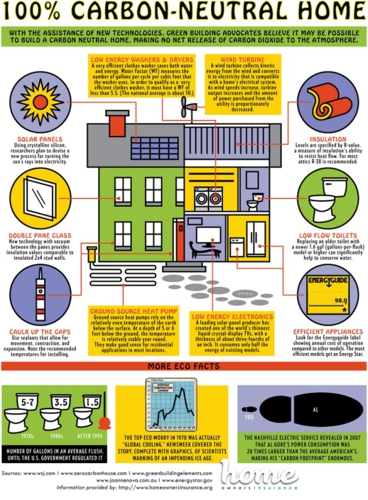For the past couple years, the idea of constructing “carbon neutral homes” has been all the rage in home building circles. Recently I stumbled across an intriguing infographic from HomeOwnersInsurance.org, which featured their idea of how the carbon neutral home of the future might look.

While the idea of personal wind turbine and even solar power might be out of reach for some homeowners, the other features of their carbon neutral design are actually quite readily available. In fact, many techniques and technologies above can be installed in your existing home, for those wishing to begin the transition to a more energy efficient home.
Double Pane Windows
When considering purchasing double pane windows over a single pane, it’s the same value proposition as purchasing a Prius. While savings estimates vary by location, double pane windows can save up to a couple hundred dollars a year, which can help you break even on the purchase in just a few short years.
Even if you don’t have the budget for new windows, it’s easy to better insulate your current windows with caulk and weather stripping. A few dollars at your local home improvement store can have a fairly dramatic impact on your energy usage, so be sure you don’t stop at your windows and also consider your exterior doors.
A layer of foam weather stripping along the door frame can easily reinforce the seal and make your home’s climate control more efficient. While better sealing your home, don’t forget about your home’s insulation. If you have an attic, replacing (or in some cases, adding) insulation can do wonders for helping to better regulate your interior temperature. As mentioned above, shop for insulation with a higher R value, which indicates its ability to resist heat flow.
Energy Efficient Appliances
It’s more than just washers and dryers; it’s televisions, computers, water heaters, and more. For a full listing on ENERGY STAR products and where to find them, check out the ENERGY STAR website. Just how much energy will an ENERGY STAR appliance save? According to the ENERGY STAR website, qualified computers can save between 30-65%, while qualified air conditioning units can save 14% on energy costs.
Before making your purchase, be sure to check for any tax credits or other incentives available, either through the government or even through your local utility provider. At the time of this writing, Duke Energy’s Smart $aver program in North Carolina offers rebates of up to $200 for qualifying HVAC systems and customers.
Geothermal Heat Pumps
Called Geothermal or ground source heat pumps, according to the U.S. Department of Energy, the additional cost of these units are recovered in just 5-10 years of usage, while system life expectancy is up to 25 years for the internal components and 50 years or more for the ground loop.
In essence, all HVAC units are heat exchangers, either changing cool air for warm or warm air for cool. Ground loops are installed up to 6 feet under the ground, where the temperature is much more consistent than the higher air temperature, allowing geothermal heat pumps to effectively cool in the summer and heat in the winter.
Low Flow Toilets
While low flow toilets can save up to thousands of gallons of water a year, they have at times been criticized for poor performance in comparison to standard toilets. However, many models now feature a much higher level of performance than those available in the 1990s.
If you’re not ready to take the “plunge,” consider a dual flush toilet. Designed to address the complaints about low flow toilets, these units have two flush choices available, one for liquid and another for solid waste.
Chris Mitchell is a freelance writer for Andrew Roby General Contractor, the Charlotte, NC area’s premier new home builder.
Don’t Wait for the “Home of the Future”: Moving Toward Energy Efficiency Today

